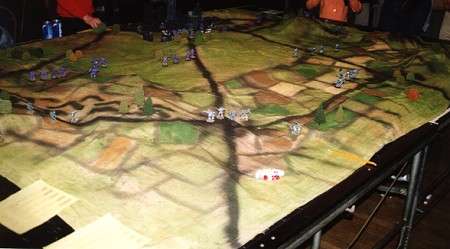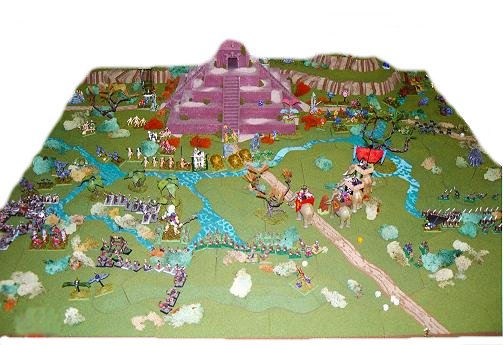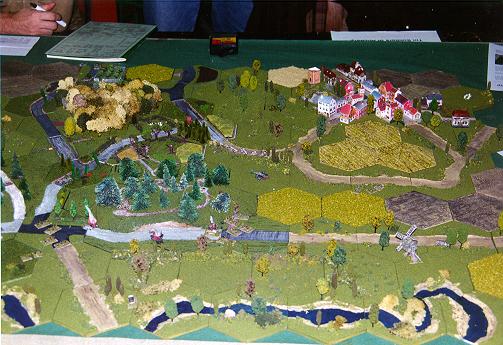

'Schild en Vriend' is an old Flemish battlecry, used in the rebellion of the city of Brugge against the French, May 18, 1302. Legend tells that it was used to differentiate between the French-speaking (who could not pronounce 'schild') and Flemish-speaking citizens. Nowadays, historians tell us that it was probably 'Des Gilden Vriend'.

The base surface of your gaming terrain is in many ways the most important factor determining the general visual appeal of the setup. Luckily, there are many options available to wargamers in choosing a base surface. Below, we'll give a rundown on a few of these.
Commercially available
As with everything in wargaming nowadays (who says we're not living in the golden age of wargaming ?), we're spoilt for choice when looking at commercially available basic terrain. Virtually every option, from your basic green cloth up to full modular terrain boards is available from some manufacturer somewhere. A random pick of the crop:
YSGC (your-standard-green-cloth)
This is the simplest and often cheapest option, but with a bit of care, it can form the foundation (literally) of a nice-looking setup. This approach involves spreading a green(ish) cloth (normal cloth or felt are the usual options) across the table, and setting the other terrain items on that. Go on, admit it, you'd never have guessed this, wouldn't you?
As it is a quick'n'dirty solution, most wargamers start out with this as their basic gaming surface, and one can probably even claim that every wargamer has at least played one, if not several, games on a green cloth of some sorts.
One option to make the surface more attractive and realistic (most battles are not fought on a football pitch) is using spraycans to spray a few irregular splotches of a different shade of green and/or brown on the cloth. This can taken even further by spraying rivers, roads etc. onto the cloth, effectively creating almost your entire terrain setup on a single cloth. That this can result in an attractive setup - admittedly with a few extra tricks such as putting styrofoam hill shapes under the cloth - can be seen on this photograph of Huntington and District Wargames Society's terrain at Fantasy Partizan '98 (photograph by Gary James of Terragenesis):

Finally, for some types of game, a ground cloth can be everything you need. Examples of this include naval games and interstellar combat games such as Full Thrust. The basic cloth for this would be blue, resp. black (unless you're in some very weird space, that is), but these can of course be treated with the 'spray painting' approach as well. This is particularly effective for the space game, where small splotches of white, blue, yellow, red, ... paint can represent stars, and wide, swirling patterns sprayed on can represent nebulas etc. Of course, these kinds of cloths are available commercially as well, and two examples of this (the GeoHex Seascape and Starscape mats), can be seen in photographs scattered around this site, e.g. in the page on Full Thrust scenery.
Terrain boards / hexes
Several companies make terrain boards, ranging from hex-based systems to fully modular terrain boards including rivers, roads, hills etc. One such company is GeoHex in the US (excuse the blatant plug (-: ), who do a hex-based terrain system with which you can build virtually every setup you can think of, in three dimensions and including roads, rivers and hills (in several flavours). Our club owns a full set of this terrain as one of our 'base surface' sets (the others are scratch built), and we're quite pleased with it. The photograph below shows one layout of the Geohex terrain (combined with a seascape mat):

Scratch-built
 Some time or other, most wargamers try their hand at building their own terrain boards. This is often a lot easier than most people seem to think, and is usually cheaper than commercial terrain. Common materials used in building terrain boards are polystyrene and plywood.
Some time or other, most wargamers try their hand at building their own terrain boards. This is often a lot easier than most people seem to think, and is usually cheaper than commercial terrain. Common materials used in building terrain boards are polystyrene and plywood.
The plywood is usually cut into squares, rectangles or hexes, on top of which is glued an equal sized board of polystyrene, which can have features such as roads, rivers and depressions carved into it. The polystyrene is then covered with some kind of plaster filler, which is finally painted and/or covered with flock to simulate the kind of terrain wanted (European, desert, steppe, ...).
Hexes or squares/rectangles
One decision that has to be made (preferably before you begin the terrain building (-: ) is what shape you want your terrain boards to be: hexagon shaped or rectangular shaped (square is just a special case of this last one). Both have advantages and disadvantages.
Hexes
Hex-based terrain has more possibilities than rectangle based, simply because a hex can be rotated through six positions and has six sides, so there are a lot more possible combinations (assuming of course, some hexes have roads, some have hills, most are plain etc.). The disadvantage (and it's a big one) of hexes is that they are a lot harder to cut than rectangles. It is after all necessary to cut out hundreds of larger or smaller hexes to such a degree of accuracy that they fit in with each other in any combination thinkable. This is not easy (understatement - I speak from experience). Being naieve, the first terrain I built consists of 6" hexes, and I vowed never to do this again (my next terrain was built on nice, big, rectangular boards). If you want to build a hex based terrain, make sure you have a good and fast way of cutting them with sufficient accuracy. If you don't, it's far preferable to go for rectangular boards.
There are, however two options to get nice, even hexes to build terrain on. One is to buy them, e.g. GHQ does (smallish) blank polystyrene hexes, and another is to resort to the terrain builders first law: if you have access to something that is hexagonal and regular, grab it and build your terrain on it. One example are card beer mats for Hoegaarden, a Belgian beer (and a very good one IMHO), which are nicely hexagonal, and are used by members of TSA, a wargame club in Antwerpen, to build many of their terrain setups, as e.g. seen in this photograph, taken at their Crisis '97 convention:

Rectangular
Rectangular boards are the opposite of hexes in both these things: they are less flexible than hexes, but they are cut very easily from polystyrene sheets, which are usually rectangular when you buy them, anyway. The second terrain set I built was based on big 0.5m x 1m rectangular polystyrene sheets, and I didn't bother cutting them to smaller sizes except where needed to increase flexibility.
Our club has three scratch-built terrain base surfaces available:
 | Desert terrain | 6" hexes |
 | Desert terrain | 0.5m square tiles and 0.5m x 1m tiles |
 | Western European terrain | 0.5m square tiles |
Clicking on the pictures above leads to a more detailed description of the materials and methods used in building these terrains.

Home | This page is maintained by Bart Vetters Schild en Vriend Miniature Wargaming Club Leuven |